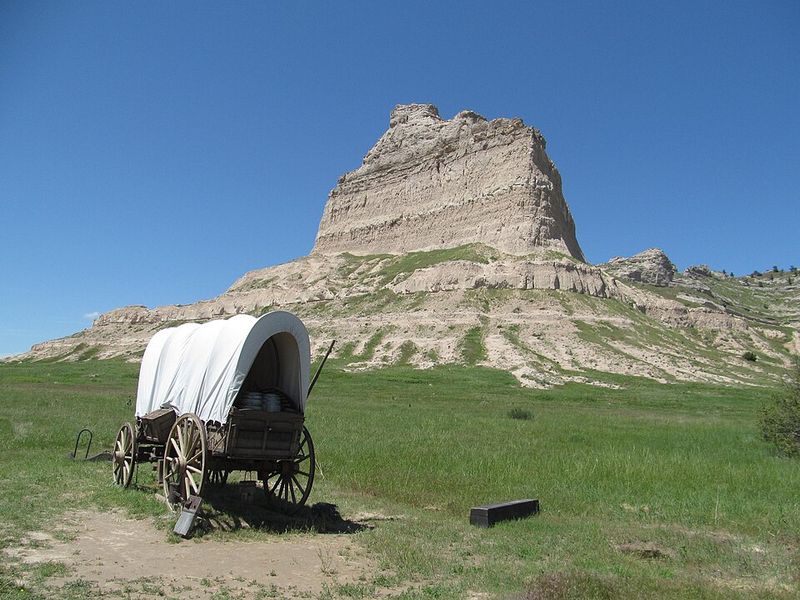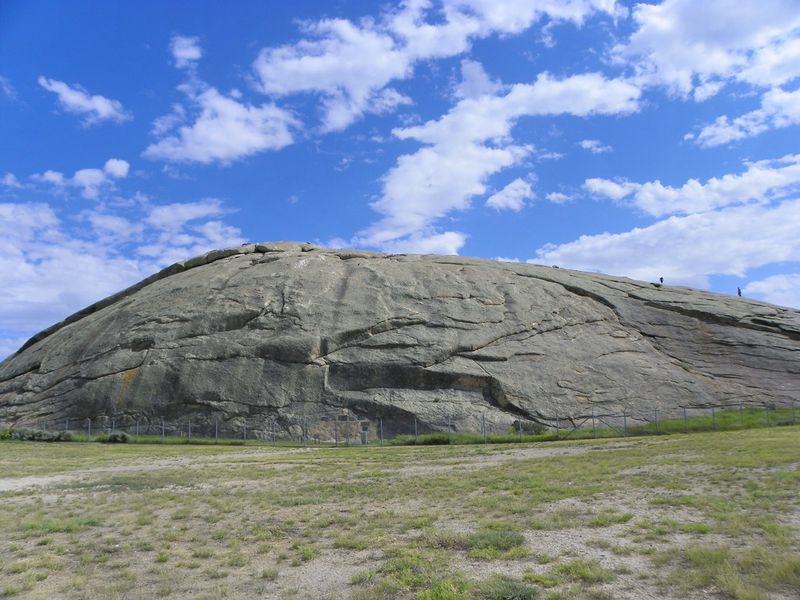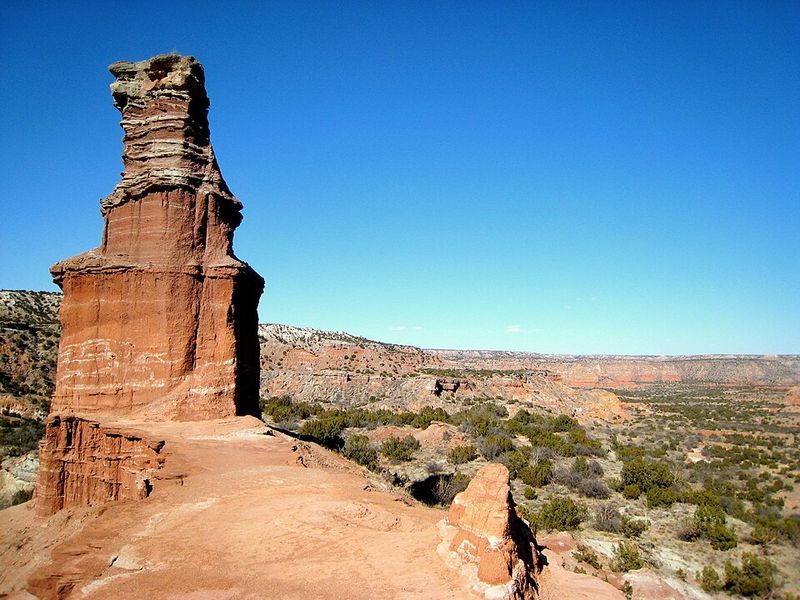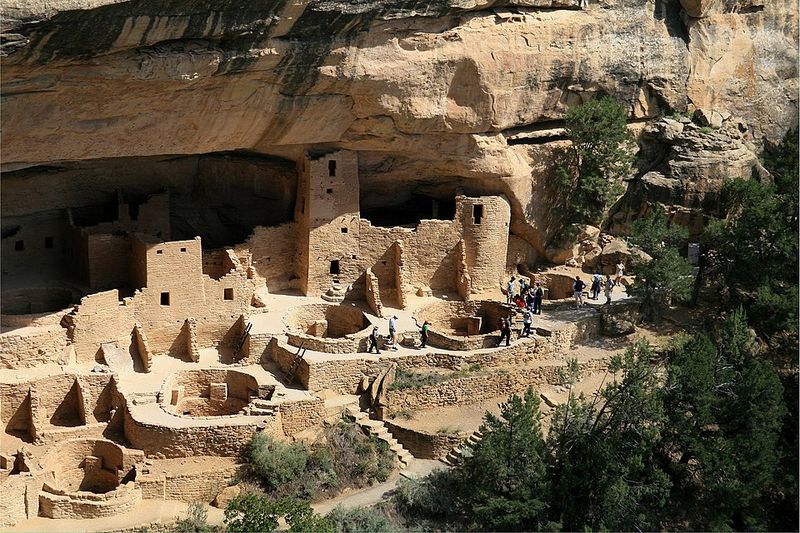America’s most famous landmarks often steal the spotlight, but hidden gems across the country offer incredible experiences without the overwhelming crowds. From dramatic canyons and ancient cliff dwellings to remote islands and frontier monuments, these overlooked destinations provide authentic adventure and rich history. Whether you’re drawn to wild forests, coastal charm, or geological wonders, these underrated landmarks promise unforgettable memories and a deeper connection to America’s diverse landscapes.
Scotts Bluff National Monument (Nebraska)
Rising from the Nebraska plains like a fortress, Scotts Bluff was a major landmark for emigrants on the Oregon, California and Mormon Trails in the mid-1800s. Its mixed-grass prairie, the North Platte River valley and sweeping views combine geology, frontier history and wide-open skies in one site.
Despite its significance, it remains far less visited than U.S. park-icons. Take the scenic drive through tunnel-roads to the summit, explore the emigrant-trail museum, and enjoy the solitude of the surrounding badlands.
For travellers seeking a tangible connection to pioneer history without the crowds, this Nebraska gem offers both education and breathtaking vistas. The isolation adds to its charm, making every visit feel like a personal discovery of America’s westward expansion story.
Independence Rock (Wyoming)
This monumental granite outcrop in central Wyoming served as “the Register of the Desert” for 19th-century emigrants who carved names on its surface. At nearly 130 feet tall and 1,900 feet long, it’s a striking geological feature and historical waypoint that tells countless pioneer stories.
Less celebrated than major national parks, Independence Rock offers striking isolation and heritage in equal measure. Visiting here gives a tangible connection to the pioneer era in a place with fewer crowds and rewarding views of the high-plateau terrain.
Scramble to the top for panoramic vistas, search for historic inscriptions, and imagine the relief emigrants felt upon reaching this milestone. The peaceful surroundings make it easy to reflect on the courage required to cross these vast plains two centuries ago.
Palo Duro Canyon State Park (Texas)
Often dubbed the “Grand Canyon of Texas,” Palo Duro Canyon features layered red and lavender rock walls, hoodoos and rugged desert terrain that rival Arizona’s famous gorge. Its status as one of the most underrated state parks highlights the fact that you can experience canyon grandeur without the heavy crowds.
Hike the popular Lighthouse Trail to see the park’s iconic rock formation, or stay in stone cabins on the canyon floor for an immersive overnight experience. Camp beneath star-filled skies and wake to sunrise painting the canyon walls in brilliant orange and pink.
Ideal for adventurous travellers wanting something different in the Lone Star State, this 120-mile-long canyon offers horseback riding, mountain biking, and an outdoor musical drama during summer months that brings Texas history to vibrant life.
Le’ala Shoreline (American Samoa)
Located on Tutuila Island, this coastline of basalt flows, tide-pools and vibrant tropical vegetation is part of an uncommonly visited U.S. territory. The remote setting keeps visitor numbers low, offering serene nature, unique geology and cultural immersion far from mainstream beach destinations.
Volcanic black rocks meet turquoise waters in dramatic contrast, while coconut palms sway overhead and tropical birds call from the forest canopy. Explore tide pools teeming with colorful marine life, or simply soak in the peaceful atmosphere of one of America’s most remote shores.
If you’re willing to travel off-the-beaten path, it offers a memorable mix of tropical wilderness and solitude that feels worlds away from typical beach vacations. The journey itself becomes part of the adventure, crossing the Pacific to discover this hidden American treasure.
Mesa Verde National Park (Colorado)
Home to well-preserved cliff-dwellings of the Ancestral Pueblo people, Mesa Verde offers deep historical resonance and dramatic landscapes that transport visitors back 700 years. The exposure of ancient masonry towers and pit-houses high in the canyon walls gives a richly layered experience more cultural than many parks.
Walk through doorways carved centuries ago, climb ladders into ceremonial kivas, and marvel at the engineering skill required to build entire villages on cliff faces. Ranger-guided tours bring the stories of these ancient inhabitants to life with fascinating archaeological details.
More peaceful and less tourist-crowded than many national parks, it’s a standout for travellers interested in archaeology, wilderness views and quieter exploration. The combination of human history and natural beauty creates an unforgettable destination that deserves far more recognition than it receives.
Congaree National Park (South Carolina)
This bottomland hardwood forest is the largest intact one left in the U.S., featuring elevated boardwalks through towering trees, swampy trails and kayak routes. Surprisingly under-visited, it offers a lush, other-worldly nature experience in the southeastern U.S. without the crowds of coastal parks.
Champion trees—some of the tallest in the eastern United States—create a cathedral-like canopy overhead, while the dark waters below reflect their massive trunks. Listen for the distinctive calls of barred owls and watch for deer, river otters, and countless bird species.
Ideal for nature lovers who want a calm forest hike, wildlife spotting or a riverside paddle through primeval wilderness. The park’s relative obscurity means you’ll often have entire sections of boardwalk to yourself, creating an intimate connection with this rare ecosystem that feels increasingly precious in our modern world.
Carlsbad Caverns National Park (New Mexico)
Deep beneath the Chihuahuan Desert lies this underground wonder: massive caverns, sweeping rock formations and one of the largest underground chambers in North America. While many visitors flock to surface-scenery parks, Carlsbad offers a subterranean twist with fewer crowds and jaw-dropping geological spectacles.
Descend 750 feet below ground into the Big Room, where formations with names like the Chandelier and Rock of Ages showcase nature’s patient artistry over millions of years. The cave maintains a constant 56 degrees, offering cool relief from desert heat above.
Visiting at dusk to watch the bat flight adds a memorable wildlife-element to the geological spectacle, as thousands of Brazilian free-tailed bats spiral out of the cave entrance in search of insects. This natural phenomenon, combined with the cave’s otherworldly beauty, creates an experience unlike any other national park.
Great Basin National Park (Nevada)
With alpine peaks, ancient bristlecone pines, cave systems and dark-sky stargazing, Great Basin National Park offers truly remote and remarkable scenery. Far less visited than many parks, it rewards those willing to venture off the main tourist loop with silence, star-filled nights and landscapes that feel undiscovered.
Stand among bristlecone pines that have survived for over 4,000 years, making them among Earth’s oldest living organisms. These gnarled, weather-beaten trees cling to high-altitude slopes, their twisted forms telling stories of millennia spent enduring harsh mountain conditions.
Tour Lehman Caves to see intricate limestone formations, then emerge to hike Wheeler Peak Trail for panoramic basin-and-range views. As darkness falls, the lack of light pollution reveals the Milky Way in stunning clarity, making this park a premier destination for amateur astronomers and anyone seeking genuine solitude in nature.
Block Island (Rhode Island)
Just off Rhode Island’s coast, this 17-mile-long island remains a calm, charming alternative to bigger beach-destinations. With dramatic cliffs, old-style lighthouses, bike trails and quiet beaches, Block Island offers a seaside retreat that avoids heavy tourism while delivering authentic New England coastal character.
Rent a bicycle to explore the island’s rolling hills and hidden coves at your own pace. Visit the iconic Southeast Lighthouse perched on Mohegan Bluffs, where 150-foot clay cliffs drop dramatically to the beach below, creating one of the most photographed scenes in New England.
A smart pick for travellers seeking beach time with character, the island maintains a laid-back atmosphere despite its proximity to major cities. Fresh seafood restaurants, Victorian hotels, and protected conservation lands make Block Island feel like stepping back to a simpler time when summers were meant for slowing down and savoring simple coastal pleasures.
Yachats (Oregon)
This small coastal town on Oregon’s “Emerald Coast” is listed among underrated U.S. destinations thanks to dramatic shorelines, less-crowded trails and charming local culture. Visiting here means wandering tide-pools, watching sea-stack sunsets and staying in quaint inns—a peaceful counterpoint to busy beach destinations.
The 804 Trail hugs the coastline through town, offering easy access to crashing waves, spouting horns, and rocky outcrops where seals sun themselves. Thor’s Well, a natural saltwater fountain, creates mesmerizing displays during high tide that draw photographers from around the world.
Local art galleries, farm-to-table restaurants, and cozy coffee shops give Yachats a creative, welcoming vibe that larger Oregon coast towns have lost to commercialization. Whether you’re searching for tide pool creatures, hiking through coastal forests, or simply watching storms roll in from a warm café, this village offers authentic coastal living without pretension.
Sawtooth National Recreation Area (Idaho)
Often overshadowed by major national parks, this Idaho wilderness area features jagged peaks, alpine lakes and miles of hiking trails—yet gets far fewer visitors. For nature-seekers wanting dramatic scenery minus the crowds, it’s a strong candidate offering year-round outdoor adventures in stunning mountain terrain.
Over 700 miles of trails wind through the Sawtooths, leading to more than 300 alpine lakes that reflect snow-capped peaks in their crystal-clear waters. Kayak on reflective lakes in summer, snowshoe in winter, and get off the beaten path to discover waterfalls, wildflower meadows, and wildlife including mountain goats and black bears.
The small town of Stanley serves as the gateway, offering rustic lodging and local hospitality without the commercialization found near more famous parks. Photographers will find endless compositions here, from sunrise over Redfish Lake to the dramatic granite spires that give the range its distinctive profile and unforgettable name.
Duluth (Minnesota)
Lakeside, historic and outdoorsy, Duluth offers a travel mix of water, trails and industrial heritage that often flies under the radar. Explore the Lake Superior shoreline where massive ore ships pass beneath the iconic Aerial Lift Bridge, creating a unique blend of natural beauty and working-port atmosphere.
Visit the historic Glensheen Mansion, a 39-room Jacobean Revival estate with manicured gardens overlooking the world’s largest freshwater lake. The mansion’s intriguing history, including a famous unsolved mystery, adds an element of intrigue to its architectural grandeur.
Take scenic drives on the North Shore toward Split Rock Lighthouse, where fall colors paint the hillsides in brilliant reds and golds. As one of the Midwest’s liveliest yet under-recognized travel hubs, Duluth combines craft breweries, local restaurants, hiking trails, and maritime museums into a surprisingly vibrant destination that deserves far more attention from travelers seeking authentic Great Lakes experiences.
Charlottesville (Virginia)
Nestled amid Virginia’s rolling hills, Charlottesville offers a potent mix of historic homes including Monticello, vineyards, downtown charm and access to the Blue Ridge Parkway. It may not grab global headlines like major cities, but its blend of culture, history and nature makes it an excellent “under-the-radar” destination for travellers.
Tour Thomas Jefferson’s architectural masterpiece Monticello to learn about the complex legacy of one of America’s founding fathers. Then spend the afternoon wine-tasting at nearby vineyards that produce world-class wines in the shadow of the Blue Ridge Mountains.
Downtown’s pedestrian mall buzzes with independent bookstores, farm-to-table restaurants, and live music venues that give the city a youthful, intellectual energy. Easy access to Shenandoah National Park and scenic Skyline Drive means you can combine cultural exploration with mountain hiking, creating a well-rounded vacation that satisfies both history enthusiasts and outdoor adventurers in equal measure.
Baxter State Park (Maine)
This remote and wild park in northern Maine, with minimal infrastructure and no paved roads in many parts, remains one of the lesser-visited major wilderness areas in the U.S. Hike to the summit of Mount Katahdin, the northern terminus of the Appalachian Trail, where triumphant thru-hikers complete their 2,000-mile journey.
Paddle pristine lakes where moose wade in shallow waters feeding on aquatic plants, their massive antlers silhouetted against morning mist. The park’s strict regulations—including limited daily visitors and no pets—preserve its wild character and ensure genuine solitude for those who make the journey.
For travellers seeking raw nature without modern conveniences, this is a gem that demands respect and preparation. The isolation adds to its appeal, offering an increasingly rare opportunity to experience wilderness on its own terms, where cell phones don’t work and the only sounds are wind, water, and wildlife moving through ancient forests.
St. Simons Island (Georgia)
Recently named the top underrated U.S. travel destination by a major travel ranking, this barrier island offers dune-lined beaches, stately live-oaks, bike paths, maritime forest and history via Fort Frederica. It’s ideal if you want a beach break with character and fewer crowds than Florida or South Carolina hotspots.
Spanish moss drapes from centuries-old live oaks, creating natural tunnels along quiet roads perfect for cycling. Climb the 1872 lighthouse for panoramic island views, then explore the museum to learn about the keeper’s tragic love story that still haunts locals’ imaginations.
Fort Frederica’s ruins tell the story of British colonial Georgia, while nearby Christ Church’s white steeple stands as a beacon for maritime travelers since the 1800s. The island’s relaxed Southern charm, combined with excellent seafood restaurants and uncrowded beaches, creates the perfect escape for families and couples seeking coastal beauty without the commercialization that has overtaken more famous beach destinations.



















